Parent's Pride
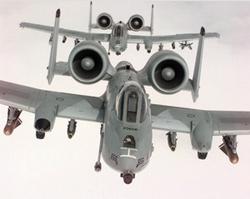 Gordon Rosenthal, 77, of Boca Raton (FL), doesn't
have a son or daughter stationed with American troops in Iraq.
Still, the retired aeronautical engineer watches the war with the
pride of a parent who does. Rosenthal's prodigy: the Air Force's
A-10 Thunderbolt II. The heavily armored, ungainly combat plane
known as the Warthog is flying close-air support missions to
protect American ground forces.
Gordon Rosenthal, 77, of Boca Raton (FL), doesn't
have a son or daughter stationed with American troops in Iraq.
Still, the retired aeronautical engineer watches the war with the
pride of a parent who does. Rosenthal's prodigy: the Air Force's
A-10 Thunderbolt II. The heavily armored, ungainly combat plane
known as the Warthog is flying close-air support missions to
protect American ground forces.
As an engineer with military contractor Fairchild Republic Co.
of Long Island, N.Y., he was a key member of the team that
developed the A-10 in the late 1960s. He eagerly reads news
reports, watches cable news and searches the Internet for any scrap
of information about the Warthog's performance in Iraq, just as he
did during the Persian Gulf War when the lumbering tank-killer saw
its first combat missions and was deemed an unqualified
success.
The "Rodney Dangerfield" Of Warplanes
"It's the Rodney Dangerfield of aircraft, that no one has any
respect for it. The Warthog is really an affectionate term. The
pilots who fly it love it," Rosenthal said. "There is only one
airplane for close-air support, and this is it."
Respect This!
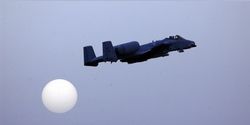 The Warthog is designed around a giant cannon, the
seven-barrel Gatling gun capable of firing 3,900 rounds per minute.
The cannon weighs about 4,000 pounds and holds 1,174 rounds of 30
mm armor-piercing ammunition. The Warthog is lethal to tanks,
artillery and other armored vehicles; pilots need to fire only for
a few seconds. The Warthog also carries Maverick anti-tank missiles
that can be fired 25 miles away from a target, Sidewinder
air-to-air missiles and a range of bombs.
The Warthog is designed around a giant cannon, the
seven-barrel Gatling gun capable of firing 3,900 rounds per minute.
The cannon weighs about 4,000 pounds and holds 1,174 rounds of 30
mm armor-piercing ammunition. The Warthog is lethal to tanks,
artillery and other armored vehicles; pilots need to fire only for
a few seconds. The Warthog also carries Maverick anti-tank missiles
that can be fired 25 miles away from a target, Sidewinder
air-to-air missiles and a range of bombs.
"The gun is really something else," said Raul Benedicto, 80, of
Boca Raton, another Fairchild Republic aeronautical engineer who
worked on the design. "The only problem with our airplane is that
it is ugly as can be. It doesn't bother me, because it was designed
to meet certain requirements."
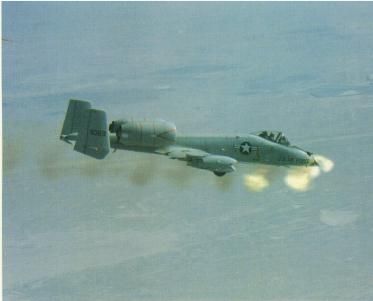
"I get a great feeling of pride seeing the damn thing in
action," Rosenthal said. "As far as I can tell, it's doing what
it's supposed to do."
Rosenthal experienced triumph and despair when the A-10 was put
into action in the 1991 Gulf War, where the Warthog is credited
with wreaking half the destruction done to Iraq's military weapons,
including tanks, Scud missiles and helicopters. The highly
maneuverable Warthog is built to withstand small-arms fire and 23
mm cannon fire. A titanium "bathtub" protects the pilot and control
systems.
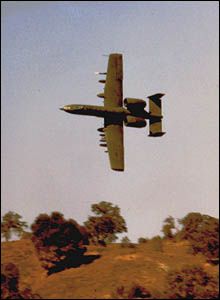 A-10 pilots charge into the thick of battle, often
loitering only hundreds of feet in the air to select targets and
move in on them with devastating results. U.S. ground troops cheer
the planes into action because they are so effective. "It's a
frightening thing when you stand on the ground and you have one of
these things coming down at you," Rosenthal said.
A-10 pilots charge into the thick of battle, often
loitering only hundreds of feet in the air to select targets and
move in on them with devastating results. U.S. ground troops cheer
the planes into action because they are so effective. "It's a
frightening thing when you stand on the ground and you have one of
these things coming down at you," Rosenthal said.
But the Warthog is not completely invulnerable; five were shot
down during the 1991 Gulf War. "I felt like a parent sending his
son off to war, and every time I saw one get hit, I felt a pang,"
Rosenthal said.
Constantine Michael, 84, of Wellington, is another retired
Fairchild Republic engineer who is proud of his work on the A-10.
"It has proven to be a good vehicle. It's kind of old for modern
day warfare, but it's the best in the house for that particular
application," he said. "It's not an aerodynamic dream, but it's a
flying tank, basically. It has all kinds of ordnance, plus the
Gatling gun."
Rosenthal avidly followed two recent stories involving Warthogs
that took enemy fire around Baghdad. One unidentified A-10 pilot
was hit by a surface-to-air missile, but he ejected safely and was
picked up by U.S. troops.
The Ballad Of "Killer Chick"
Another dramatic mission unfolded when Air Force Capt. Kim
Campbell was called in to assist ground troops. Campbell is known
by her call sign "KC," for "Killer Chick." She took heavy fire in
Her A-10 took heavy fire that crippled its redundant hydraulic
control systems.
If both systems fail, the Warthog can be flown manually, though
it is difficult. Engineers designed and extensively tested the
plane so it could return home with heavy damage, even missing large
pieces (file photo, below).
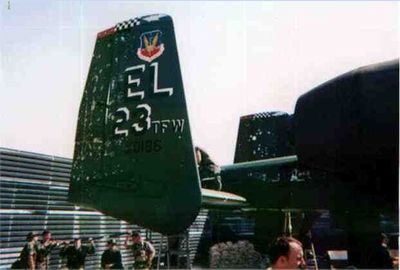
Campbell was determined to get her plane back to base, and she
succeeded after an hour-long struggle. Her squadron members
marveled at the damage the plane sustained -- the empinage was
riddled with holes, and a 1-foot section of a rear stabilizer had
been blown off.
"The plane is designed to come home. We designed it specially
with those requirements," Benedicto said.
Only about 720 Warthogs were built, and Rosenthal laments that
there are no other planes in development for the Air Force that
would improve upon the Warthog's capabilities. There are 359
Warthogs in the Air Force's fleet, and there are plans to keep
updating the planes through 2011.
Rosenthal said every aspect of the plane was conceived to make
it the companion in the sky to ground troops. "That's the only way
you win the war, by winning the battle on the ground," he said.
"It's not sexy," Benedicto said. "It's functional."
 ANN's Daily Aero-Term (05.05.25): Circle To Runway (Runway Number)
ANN's Daily Aero-Term (05.05.25): Circle To Runway (Runway Number) ANN's Daily Aero-Linx (05.05.25)
ANN's Daily Aero-Linx (05.05.25) NTSB Prelim: De Havilland DHC-1
NTSB Prelim: De Havilland DHC-1 Classic Aero-TV: The Boeing Dreamliner -- Historic First Flight Coverage
Classic Aero-TV: The Boeing Dreamliner -- Historic First Flight Coverage Airborne-NextGen 05.06.25: AF Uncrewed Fighters, Drones v Planes, Joby Crew Test
Airborne-NextGen 05.06.25: AF Uncrewed Fighters, Drones v Planes, Joby Crew Test







